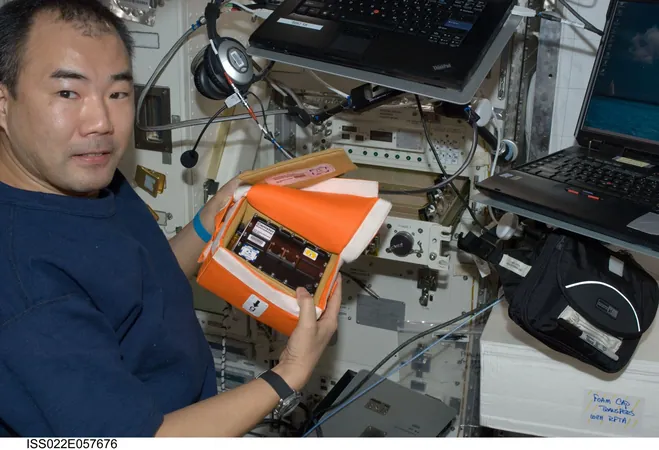
Groundbreaking Discoveries from the Space Station: Revolutionary Cancer Treatments, Eco-Friendly Satellites, and the Secrets of Glass Formation!
2024-11-25
Author: Daniel
Groundbreaking Discoveries from the Space Station: Revolutionary Cancer Treatments, Eco-Friendly Satellites, and the Secrets of Glass Formation!
Recent research from the International Space Station (ISS) is shedding light on exciting advancements in medicine, sustainability, and material science that could change our world forever.
Revolutionary Space-Grown Crystals and Cancer Drug Development
In an extraordinary scientific feat, researchers have harnessed the unique environment of microgravity to grow highly structured protein crystals, which could lead to the development of targeted cancer therapies. By studying these crystals, scientists uncovered the structure of a helix-loop-helix (HLH) peptide in conjunction with vascular endothelial growth factor-A (VEGF). VEGF is crucial in the formation of new blood vessels, and inhibiting it has become a promising strategy to halt tumor growth.
This breakthrough indicates that HLH peptides could be vital in crafting medications aimed directly at disease-related proteins like VEGF, potentially revolutionizing cancer treatment. This project, conducted by the Japan Aerospace Exploration Agency (JAXA), illustrates how the microgravity environment of the ISS facilitates the production of crystal structures that are more refined than those achieved on Earth, offering invaluable insights for drug design.
Wood: The Sustainable Material for Future Satellites?
In a surprising twist, research indicates that certain types of wood could play a critical role in making satellite technology more sustainable. After being exposed to the harsh conditions of space for about 10 months, wood samples showed no significant changes in weight or erosion from atomic oxygen. This resilience could prompt engineers to consider using wood in satellite construction to mitigate the environmental impact associated with traditional metal satellites.
When metallic satellites re-enter Earth's atmosphere, they can generate harmful particles and aerosols that threaten the ozone layer. In contrast, wood decomposes into benign substances — primarily water and carbon dioxide — upon reentry, making it a more environmentally friendly option for future space missions. JAXA's investigation into the effects of space on wood examined various environmental factors, such as atomic oxygen and cosmic rays, providing crucial data for selecting the right types of wood and their applications in aerospace technology.
Unlocking the Mysteries of Glass Formation with Magnesium Silicates
Another fascinating component of this week's findings concerns the properties of magnesium silicates, widely recognized for their significance in both glass science and geoscience. Recent studies have revealed critical structural and atomic details about glassy and liquid magnesium silicates. Researchers found that the electronic structure didn’t largely influence how these materials form glasses; instead, it was the atomic arrangement that held the key.
Through JAXA's Fragility project, scientists measured various thermophysical properties, such as density and viscosity of oxidized molten metals, utilizing the ISS’s Electrostatic Levitation Furnace (ELF). This high-tech facility allows researchers to analyze material behaviors without the constraints of containers, offering unprecedented insight into glass formation processes and the discovery of innovative materials.
Conclusion
The recent findings from the ISS not only pave the way for potential advancements in targeted cancer treatments and eco-friendly satellite technology but also deepen our understanding of material science, particularly the formation of glass. As these studies continue, they bring us closer to breakthroughs that could redefine our approach to health, sustainability, and materials engineering! Stay tuned, as the cosmos continues to inspire revolutionary change right here on Earth!

 Brasil (PT)
Brasil (PT)
 Canada (EN)
Canada (EN)
 Chile (ES)
Chile (ES)
 España (ES)
España (ES)
 France (FR)
France (FR)
 Hong Kong (EN)
Hong Kong (EN)
 Italia (IT)
Italia (IT)
 日本 (JA)
日本 (JA)
 Magyarország (HU)
Magyarország (HU)
 Norge (NO)
Norge (NO)
 Polska (PL)
Polska (PL)
 Schweiz (DE)
Schweiz (DE)
 Singapore (EN)
Singapore (EN)
 Sverige (SV)
Sverige (SV)
 Suomi (FI)
Suomi (FI)
 Türkiye (TR)
Türkiye (TR)